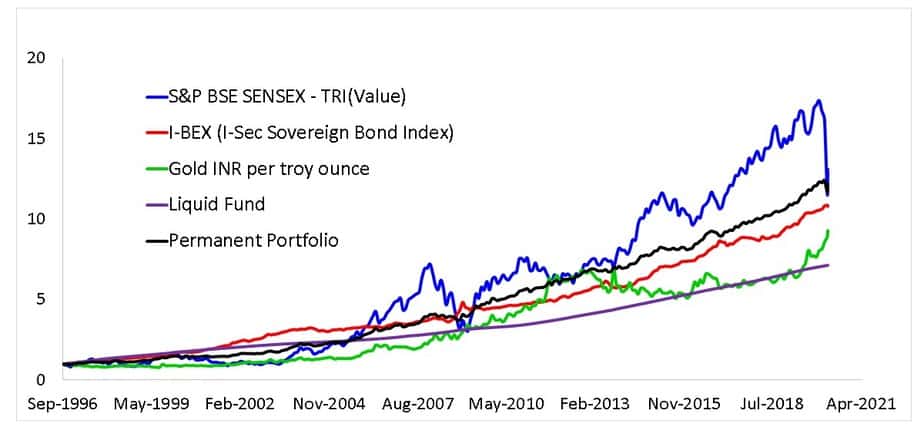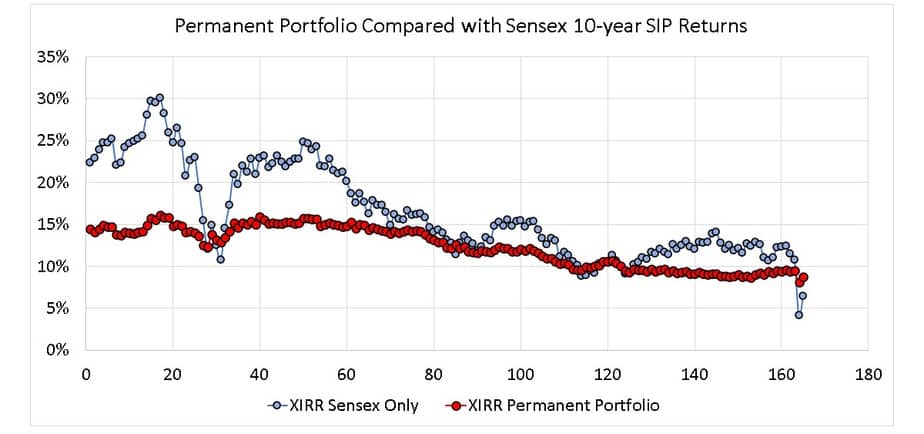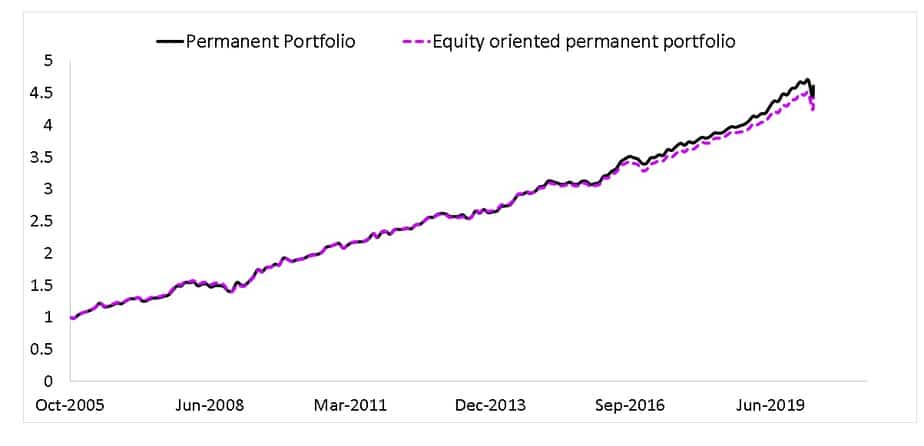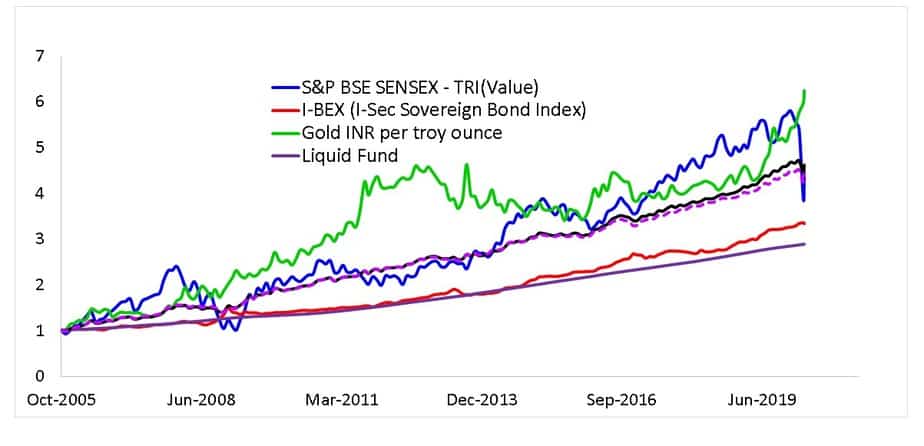Last Updated on December 29, 2021 at 5:31 pm
Here is an example of an all-weather portfolio that works in all market conditions: bull market, bear market, recession, fear, uncertainty, inflation, deflation. Will you use such a portfolio or invest in such a mutual fund if it is available in a tax-friendly manner?
In July 2013, we had analysed the Permanent Portfolio in an alternative investing paradigm developed by American investment adviser Harry Browne in 1981. The permanent portfolio comprises of stocks, bonds, cash and gold in equal proportions (25%)! This sounds bizarre because for long term goals most investment advisers would recommend (1) significant equity exposure. Typically 100-age. That is 65% equity allocation for a 35-year-old and rest in debt. (2) little or no gold exposure (not more than 10%) (3) little or no cash.
How can such an unconventional portfolio allocation work for long term goals? The idea behind the permanent portfolio is fascinatingly simple. In his book (Google PLay ebook for Rs. 379), Fail-Safe Investing: Lifelong Financial Security in 30 Minutes, Browne writes about four possible economic conditions:
Join 32,000+ readers and get free money management solutions delivered to your inbox! Subscribe to get posts via email! (Link takes you to our email sign-up form)
🔥Want to create a complete financial plan? Learn goal-based investing? Exclusive access to our DIY tools? Increase your income with your skills? Use this link to enjoy massive discounts on our robo-advisory tool & courses! 🔥
 Prosperity when markets do exceedingly well
Prosperity when markets do exceedingly well- Recession a general slowdown in one or more aspects of the economy
- Inflation No need to explain this one, right?!
- Deflation Negative inflation. Believe it or not, has occurred in the past!
The idea of the permanent portfolio is to choose instruments which will do well in one or more of the above conditions. According to Browne, these are:
- Stocks When the markets do well. Direct equity or mutual funds. Even an index fund should do.
- Cash during a recession. For example a liquid fund
- Gold during inflation
- Long Term Bonds during deflation and prosperity
Thus the permanent portfolio is 25% Stocks, 25% Cash, 25% Gold and 25% bonds. To ensure in Browne’s words, “an investor is financially safe, no matter what the future brings”.
While it is quite easy to dismiss this portfolio as conservative, it is naturally low volatile, but still effective combination. In this article, the July 2013 study is updated with better data. A tax-efficient alternative is also presented.
- Stocks: Sensex TRI from Sep 1996.
- Cash: NAV of JM Liquid fund India’s oldest liquid fund is used. The fund was launched on 31st Dec 1997. We have a used a simple extrapolation based on the average of the first 100 daily returns to generate data until Sep 1996
- Gold: Gold price in INR per troy ounce from Sep 1996
- Long Term Bonds: I-BEX Long Term Gilt Index from Sep 1996.
This would be the performance of a mutual fund following the permanent portfolio since Sep 1996 with monthly rebalancing.

Now, it is easy to be dismissive that the permanent portfolio “has done well only after a market crash”. Not true at all when you look at 165 10-year SIP returns.

The spread in returns is less and until recently it has managed a double-digit return. The general downward trend is also true for equity as well. The permanent portfolio has also done well with respect to the 50% stocks + 50% bonds portfolio of Ben Graham discussed yesterday.

Now such a portfolio will not be tax efficient even with annual rebalancing and even if a mutual fund adopts this, it will only be classified as a debt fund by the IT depart. Can this idea be implemented via arbitrage?
- Direct Equity 25%
- Arbitrage 40% (total equity 65% to qualify as an equity fund by the IT dept)
- Gold 25%
- Gilts 5%
- Cash 5%
Using Kotak Arbitrage (oldest in the category) this is a comparison of the permanent portfolio with an equity-oriented permanent portfolio. The agreement is reasonable to say the least!

The other asset classes have been included for reference.

In conclusion, the permanent portfolio is an excellent all-weather portfolio. A simple annual rebalancing is sufficient if an investor implements this, but most will not as they fear taxes more than a capital loss! Mutual funds can implement it with monthly rebalancing but would be treated as debt funds. An equity-oriented variant can easily be constructed.
The key result is, such a portfolio is capable of producing a reasonable return with significantly lower uncertainty. An investor might be quick to criticise, “will such a portfolio beat inflation over the long term?”. Sadly, even a traditional long-term portfolio stuffed with equity does not do this!
An investor who finds this mix appealing also finds the lower uncertainty in future returns appealing. That is prudent thinking, not conservative. Multi-risk funds would do better if they adopt strict asset allocations such as this instead of the vague “min 10% weight to each asset class”.

Use our Robo-advisory Tool to create a complete financial plan! ⇐More than 3,000 investors and advisors use this! Use the discount code: robo25 for a 20% discount. Plan your retirement (early, normal, before, and after), as well as non-recurring financial goals (such as child education) and recurring financial goals (like holidays and appliance purchases). The tool would help anyone aged 18 to 80 plan for their retirement, as well as six other non-recurring financial goals and four recurring financial goals, with a detailed cash flow summary.
🔥You can also avail massive discounts on our courses and the freefincal investor circle! 🔥& join our community of 8000+ users!
Track your mutual funds and stock investments with this Google Sheet!
We also publish monthly equity mutual funds, debt and hybrid mutual funds, index funds, and ETF screeners, as well as momentum and low-volatility stock screeners.
You can follow our articles on Google News

We have over 1,000 videos on YouTube!

Join our WhatsApp Channel



- Do you have a comment about the above article? Reach out to us on Twitter: @freefincal or @pattufreefincal
- Have a question? Subscribe to our newsletter using the form below.
- Hit 'reply' to any email from us! We do not offer personalised investment advice. We can write a detailed article without mentioning your name if you have a generic question.
Join 32,000+ readers and get free money management solutions delivered to your inbox! Subscribe to get posts via email! (Link takes you to our email sign-up form)
About The Author
 Dr M. Pattabiraman (PhD) is the founder, managing editor and primary author of freefincal. He is an associate professor at the Indian Institute of Technology, Madras. He has over 13 years of experience publishing news analysis, research and financial product development. Connect with him via Twitter(X), LinkedIn, or YouTube. Pattabiraman has co-authored three print books: (1) You can be rich too with goal-based investing (CNBC TV18) for DIY investors. (2) Gamechanger for young earners. (3) Chinchu Gets a Superpower! for kids. He has also written seven other free e-books on various money management topics. He is a patron and co-founder of “Fee-only India,” an organisation promoting unbiased, commission-free, AUM-independent investment advice.
Dr M. Pattabiraman (PhD) is the founder, managing editor and primary author of freefincal. He is an associate professor at the Indian Institute of Technology, Madras. He has over 13 years of experience publishing news analysis, research and financial product development. Connect with him via Twitter(X), LinkedIn, or YouTube. Pattabiraman has co-authored three print books: (1) You can be rich too with goal-based investing (CNBC TV18) for DIY investors. (2) Gamechanger for young earners. (3) Chinchu Gets a Superpower! for kids. He has also written seven other free e-books on various money management topics. He is a patron and co-founder of “Fee-only India,” an organisation promoting unbiased, commission-free, AUM-independent investment advice.Our flagship course! Learn to manage your portfolio like a pro to achieve your goals regardless of market conditions! ⇐ More than 3,500 investors and advisors are part of our exclusive community! Get clarity on how to plan for your goals and achieve the necessary corpus no matter the market condition!! Watch the first lecture for free! One-time payment! No recurring fees! Life-long access to videos! Reduce fear, uncertainty and doubt while investing! Learn how to plan for your goals before and after retirement with confidence.
Increase your income by getting people to pay for your skills! ⇐ More than 800 salaried employees, entrepreneurs and financial advisors are part of our exclusive community! Learn how to get people to pay for your skills! Whether you are a professional or small business owner seeking more clients through online visibility, or a salaried individual looking for a side income or passive income, we will show you how to achieve this by showcasing your skills and building a community that trusts and pays you. (watch 1st lecture for free). One-time payment! No recurring fees! Life-long access to videos!
Our book for kids: “Chinchu Gets a Superpower!” is now available!


Must-read book even for adults! This is something that every parent should teach their kids right from their young age. The importance of money management and decision making based on their wants and needs. Very nicely written in simple terms. - Arun.Buy the book: Chinchu gets a superpower for your child!
How to profit from content writing: Our new ebook is for those interested in getting a side income via content writing. It is available at a 50% discount for Rs. 500 only!
Do you want to check if the market is overvalued or undervalued? Use our market valuation tool (it will work with any index!), or get the Tactical Buy/Sell timing tool!
We publish monthly mutual fund screeners and momentum, low-volatility stock screeners.
About freefincal & its content policy. Freefincal is a News Media organisation dedicated to providing original analysis, reports, reviews and insights on mutual funds, stocks, investing, retirement and personal finance developments. We do so without conflict of interest and bias. Follow us on Google News. Freefincal serves more than three million readers a year (5 million page views) with articles based only on factual information and detailed analysis by its authors. All statements made will be verified with credible and knowledgeable sources before publication. Freefincal does not publish paid articles, promotions, PR, satire or opinions without data. All opinions will be inferences backed by verifiable, reproducible evidence/data. Contact Information: To get in touch, please use our contact form. (Sponsored posts or paid collaborations will not be entertained.)
Connect with us on social media
- Twitter @freefincal
- Subscribe to our YouTube Videos
- Posts feed via Feedburner.
Our publications
You Can Be Rich Too with Goal-Based Investing
 Published by CNBC TV18, this book is designed to help you ask the right questions and find the correct answers. Additionally, it comes with nine online calculators, allowing you to create custom solutions tailored to your lifestyle. Get it now.
Published by CNBC TV18, this book is designed to help you ask the right questions and find the correct answers. Additionally, it comes with nine online calculators, allowing you to create custom solutions tailored to your lifestyle. Get it now.Gamechanger: Forget Startups, Join Corporate & Still Live the Rich Life You Want
 This book is designed for young earners to get their basics right from the start! It will also help you travel to exotic places at a low cost! Get it or gift it to a young earner.
This book is designed for young earners to get their basics right from the start! It will also help you travel to exotic places at a low cost! Get it or gift it to a young earner.Your Ultimate Guide to Travel
 This is an in-depth exploration of vacation planning, including finding affordable flights, budget accommodations, and practical travel tips. It also examines the benefits of travelling slowly, both financially and psychologically, with links to relevant web pages and guidance at every step. Get the PDF for Rs 300 (instant download)
This is an in-depth exploration of vacation planning, including finding affordable flights, budget accommodations, and practical travel tips. It also examines the benefits of travelling slowly, both financially and psychologically, with links to relevant web pages and guidance at every step. Get the PDF for Rs 300 (instant download)